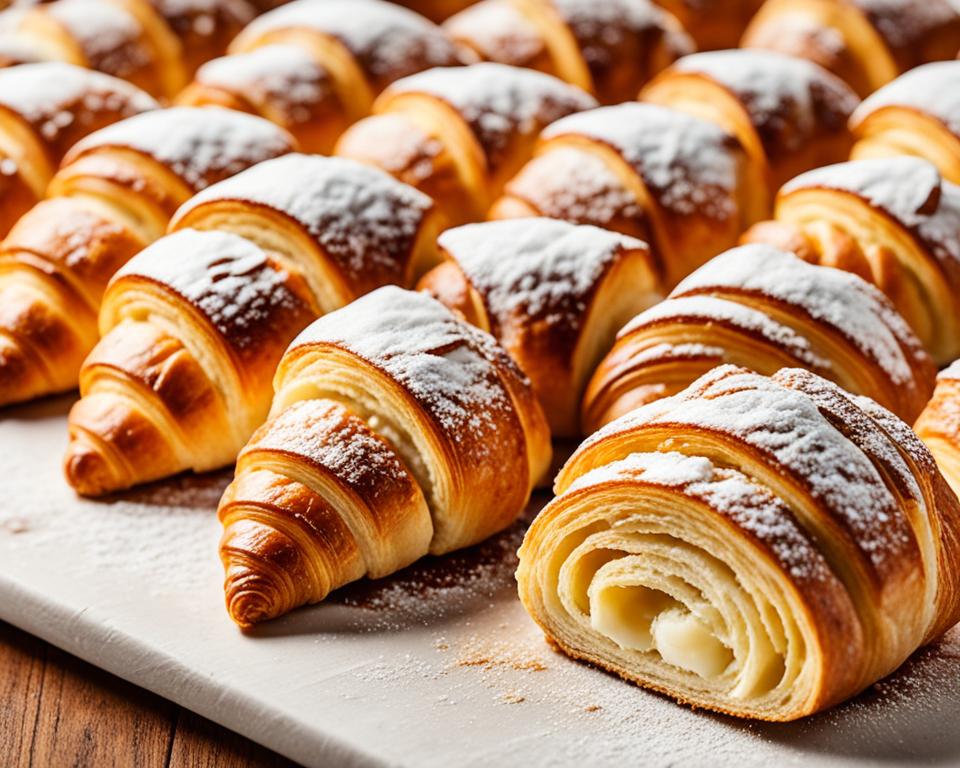Step into the enchanting world of croissant rolls, where flaky layers of buttery perfection await. These beloved French pastries have won hearts worldwide. They delight people from all walks of life. We’ll explore the secrets behind these treats, from viennoiserie to laminated dough.
Croissant rolls are a key part of French baking. They’ve become a favorite for breakfast and afternoon treats. This guide is for both passionate home bakers and those looking for the best croissant rolls. Get ready to enjoy the flaky, buttery goodness of these treats.
Read interesting things at : grenzgamer
Key Takeaways
- Discover the art of viennoiserie and its role in creating flaky croissant rolls
- Explore the intricate process of laminated dough, the foundation of these buttery pastries
- Learn about the importance of high-quality ingredients, particularly the use of premium butter
- Gain insights into traditional French baking techniques and their influence on croissant rolls
- Dive into the step-by-step guide to mastering the art of croissant roll making
Croissant Rolls: A Baked Delicacy
Croissant rolls are part of the viennoiserie family. This group of baked goods comes from Vienna, Austria. They are known for their flaky, buttery taste. This comes from a special process called laminating the dough.
Understanding the Art of Viennoiserie
The word “Viennoiserie” comes from “Viennois,” meaning “of Vienna.” It talks about the special baking methods and recipes used in these pastries. Making viennoiserie requires a lot of skill. Bakers must carefully layer dough and butter to get that flaky texture.
The Buttery Flakiness of Laminated Dough
Laminating the dough is what makes croissant rolls so flaky. By putting layers of dough and butter together, bakers create a special structure. This process, called laminated dough, lets the dough puff up and split into thin layers in the oven. This makes the rolls melt in your mouth.
“The art of viennoiserie is a delicate dance between dough and butter, creating a symphony of flavors and textures.”
The mix of viennoiserie tradition and laminated dough skills makes french bakery croissant rolls special. They are a true treat for the taste buds.
Traditional French Baking Techniques
The art of making croissant rolls comes from deep French baking traditions. For generations, French pastry chefs have honed their skills. They focus on the precise folding of dough and careful baking temperatures. This makes sure the pastries are both buttery and delicate.
Laminating the dough is a key step in traditional French viennoiserie. This means layering butter between thin pastry sheets. It gives the dough its flaky texture and keeps it intact when rolled and shaped.
Getting the traditional French bakery methods right requires precision. The dough’s temperature and humidity must be just right for it to rise and bake well. Using top-quality ingredients like European-style butter and premium flour also boosts the taste and texture.
“The true essence of a croissant roll lies in the perfect harmony of its layers, where each bite unveils a symphony of buttery goodness and airy lightness.”
By sticking to these classic baking methods, French pastry chefs turn the simple croissant roll into a masterpiece. It’s a tasty symbol of France’s rich food culture.
Ingredients for Irresistible Croissant Rolls
The secret to making amazing croissant rolls is using top-notch ingredients. At the core, the butter is key. It must be of the highest quality for that rich, buttery taste and soft texture.
The Importance of High-Quality Butter
Butter is crucial for croissant rolls, and its quality matters a lot. The best ones use European-style butter. This type has more fat and a deeper flavor. It’s vital for making the dough that makes croissant rolls flaky.
Choosing the Right Flour for Perfection
Flour is also key for croissant rolls. Bakers often pick all-purpose or bread flour. These flours are strong enough for the dough’s complex process of lamination. They help make a dough that can be folded and rolled many times without falling apart.
By picking and mixing these important ingredients well, bakers can make croissant rolls that look great and taste amazing.
“The secret to making the perfect croissant roll is in the quality of the butter and flour. Without these two essential ingredients, you simply can’t achieve that signature flakiness and buttery flavor.”
Step-by-Step Guide to Making Croissant Rolls
Making perfect croissant rolls at home needs patience and focus. The secret to the flaky layers is in folding the dough well. By using a detailed recipe and the lamination process, you can make laminated dough at home. Enjoy the warm, buttery taste of viennoiserie straight from the oven.
Mastering the Dough Folding Technique
The dough folding is key to making baking croissant rolls. You need to layer the dough with cold butter, then fold and chill it. This makes the flaky layers everyone loves. Here’s how to fold the dough like a pro:
- Prepare the dough: Mix the ingredients to get a smooth dough. Chill it for at least an hour to relax the gluten.
- Roll and fold the dough: Roll the dough into a long rectangle. Fold it like a letter and chill for 30 minutes.
- Repeat the folding: Roll and fold the dough again, chilling it between folds. This makes the layers and flakiness.
- Shape and proof the dough: After lamination, shape the dough into crescent rolls. Let them proof until they’re big.
- Bake to perfection: Brush the rolls with egg wash and bake until they’re golden and flaky.
By following these steps and mastering dough folding, you can make laminated dough that’s as good as Parisian viennoiserie bakeries.
Variations and Fillings
The classic croissant roll is amazing on its own. But, it also lets you get creative with fillings. You can try the famous pain au chocolat (chocolate-filled croissant) or go for savory like ham and cheese. The choices are endless with croissant rolls.
Sweet and Savory Options
Bakers can play with different flavors and ingredients. This makes croissant rolls great for any event. Whether you want something sweet or savory, there’s a croissant roll for you.
- Pain au chocolat: Flaky croissant dough wrapped around rich, melted chocolate
- Almond croissant: Croissant filled with a creamy almond paste
- Cheese and ham croissant: Savory combination of flaky pastry, melted cheese, and sliced ham
- Veggie-filled croissant: Croissant stuffed with a variety of sautéed or roasted vegetables
Croissant rolls are great for trying out new baked goods and breakfast pastries. They’re perfect for both sweet and savory cravings. Whether you want a classic pain au chocolat or something new, there’s a croissant roll for you.
“Croissant rolls are the perfect canvas for culinary creativity, allowing bakers to showcase their skills and delight their customers with an endless array of flavors and textures.”
Croissant Rolls: A Breakfast Delight
The breakfast pastries known as croissant rolls are a favorite in French bakery culture. They are flaky and buttery, making them perfect with coffee or tea. These pastries make mornings special with their unique taste and feel.
The mix of the croissant’s flakiness and sweetness makes them a must-have in the morning. Enjoy them alone or with jams and compotes. Croissant rolls turn a simple morning into a special treat.
The dough’s rich, buttery taste comes from a careful process. Layers of dough and butter are folded and rolled. This makes the French bakery croissant rolls stand out, offering a great taste every time.
“Croissant rolls are the epitome of the French breakfast experience – a perfect balance of decadence and refinement.”
For many, eating a croissant roll with a warm drink is a special moment. It’s a time to relax and enjoy life. These breakfast pastries bring people together, creating comfort and nostalgia.
As the day starts and the smell of fresh croissant rolls fills the air, it’s clear why they’re loved. From their flaky outside to their soft inside, each bite shows the skill of French baking. These baked goods make mornings happier.
Storing and Reheating Croissant Rolls
Keeping baked goods like croissant rolls fresh is key to enjoying them fully. The right storage methods help keep these breakfast pastries flaky and buttery.
For the best results, store croissant rolls in an airtight container. Don’t refrigerate them as cold, dry air can make them stale. Keep them at room temperature, away from sunlight or heat.
To make your croissant rolls taste fresh again, just reheat them. A few minutes in the oven or a toaster can bring back their warm, inviting taste. This makes them a great choice for any time of day.
| Storage Method | Recommended Duration | Resulting Texture |
|---|---|---|
| Airtight Container (Room Temperature) | Up to 3 days | Flaky and Buttery |
| Refrigerator | Not Recommended | Stale and Dry |
| Freezer | Up to 1 month | Soft and Doughy (Requires Thawing and Reheating) |
By using these easy storage and reheating tips, you can enjoy the amazing taste and texture of croissant rolls anytime. This ensures a great baked goods experience every time.
The History of Croissant Rolls
The iconic french bakery staple, the croissant roll, has a rich history. It goes back centuries. These flaky, buttery baked goods started in the 13th century with Austrian bakers. They created the crescent-shaped pastry.
In France, the viennoiserie delicacy became popular. French pastry chefs worked hard to perfect the croissant rolls we love today. These pastries are now a big part of France’s baking traditions. They have won the hearts and taste buds of people all over the world.
“The croissant roll is not just a pastry, it’s a piece of art, a testament to the passion and skill of French bakers.”
The croissant roll has changed a lot over time. French baked goods artisans have made it what it is today. They perfected the crescent shape and the dough laminating process. This made the croissant rolls flaky, buttery, and full of flavor.
Now, the croissant roll is a symbol of French culinary excellence. It delights people at french bakery places all over the world. Its timeless charm still wins over food lovers. They love the art and history in every bite.
Pairing Croissant Rolls with Beverages
Croissant rolls are more than just rich pastries. They are perfect for breakfast or an afternoon treat. These breakfast pastries go well with many drinks, making the experience even better.
A strong cup of French-pressed coffee is a classic choice with croissant rolls. The coffee’s rich taste matches the buttery baked goods well. This makes for a great taste balance.
For a special treat, try croissant rolls with hot chocolate. The mix of the flaky pastry and creamy hot chocolate is amazing. It’s a great mix of textures and tastes.
Croissant rolls also go well with fresh orange juice. The bright citrus flavor cuts through the richness of the french bakery treat. It’s a refreshing and balanced choice.
“The right beverage can transform a simple croissant roll into a truly memorable experience.”
Whether you like strong coffee, rich hot chocolate, or fresh orange juice, there are many drink options. Try different drinks to find your favorite. This will make your morning or afternoon even better.

Croissant Rolls Around the World
The croissant roll started in French cooking but has spread worldwide. It’s loved in cafes from Paris to New York City. This french bakery favorite has made bakers and pastry lovers try their own twist on it.
The popularity of breakfast pastries is rising. This has led to many regional and artisanal versions of the croissant roll. Bakers all over the world have made their own versions, using local ingredients and tastes.
In Japan, the croissant roll is light and fancy, filled with sweet red bean paste or savory meats. In Scandinavia, it’s paired with smoked salmon and dill, showing off the region’s food traditions.
In Europe’s busy cities, the croissant roll is a morning favorite. Bakeries and cafes offer many flavors to please everyone. You can find everything from classic buttery ones to new tastes like chocolate-hazelnut and caramelized onion.
The croissant roll is loved all over the world. It shows how French baking traditions can inspire new tastes. Enjoying it in a Paris cafe or a local bakery, it’s a symbol of how food brings people together.
The Rise of Artisanal Bakeries
In recent years, people have wanted more high-quality, artisanal baked goods. Croissant rolls have led this trend. Skilled pastry chefs and bakers use traditional techniques and the best ingredients. This has made croissant rolls even better.
Artisanal french bakeries are now places where pastry lovers go. They offer croissant rolls that show off the classic French taste. These rolls have a flaky outside and a soft inside, making them a treat for anyone who tries them.
For those who love baked goods, artisanal bakeries are the top choice. They look for the perfect mix of old and new. These bakeries get their ingredients locally. They use top-notch butter, flour, and other key items for their croissant rolls.
“The true art of croissant making lies in the mastery of laminated dough and the patience required to achieve those delicate, flaky layers.”
The croissant roll is now a big hit in the world of artisanal baked goods. It shows off the skill and hard work of these talented bakers. By keeping traditional methods and using better ingredients, artisanal bakeries have changed how we enjoy this French pastry.
Croissant Rolls: The Perfect Indulgence
In the world of breakfast pastries and tasty baked goods, the croissant roll stands out. These French treats are known for their flaky layers and buttery taste. They are perfect for a special morning treat, an afternoon snack, or a dessert for a big event. Croissant rolls can take you to a place of pure joy.
Making the perfect croissant roll takes skill and hard work from French bakery experts. They pick top-quality ingredients and use a special dough-making method. This makes a pastry that looks great and tastes amazing. Its flaky outside and soft, buttery inside are a treat to eat.
“Indulging in a freshly baked croissant roll is a true culinary experience, one that transcends the boundaries of mere sustenance and becomes a celebration of the senses.”
If you want a top-notch food experience, choose the croissant roll. It’s great with a rich coffee or by itself. This pastry gives you a moment of pure happiness. It’s a taste of French baked goods at its best.

The croissant roll is more than just tasty. It brings back memories and connects us to French culture. When you bite into it, you feel like you’re in a French bakery. The smell of fresh pastries fills the air, and you enjoy the simple pleasures of life.
Conclusion
The croissant roll is a true masterpiece in the world of baked treats. It comes from French roots and has become a symbol of luxury and culinary skill. We’ve looked into how to make croissant rolls, the traditional French baking methods, and the many fillings available.
As we end our exploration of croissant rolls, we appreciate the art of baked goods more. We also recognize the talent of those who make these flaky pastries. This guide and inspiration will help you make delicious croissant rolls at home or find the best bakeries.
The croissant roll shows the lasting charm of French cooking, mixing old and new in a delightful way. Enjoying the buttery layers and flaky texture, let it inspire you to start your own cooking adventure. Discover the unique tastes and experiences that make the croissant roll so special.



